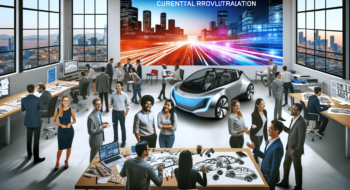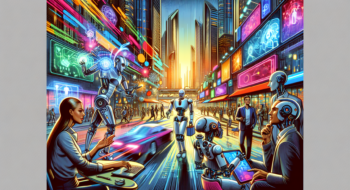Navigating the Future of Mobility
As we advance into the era of innovative engineering, the automotive industry stands at a pivotal crossroads, redefining the ways we approach design, manufacturing, and consumer interaction. With trends such as electrification, automation, and sustainability gaining momentum, automotive companies are not only adapting but also thriving amidst rapid technological changes. This article delves into the latest insights and advancements shaping the automotive landscape, exploring how these trends are poised to impact the future of mobility and consumer experiences.
1. Electrification: Powering the Future
Electric vehicles (EVs) have transitioned from being a niche market to a core component of the automotive industry. Manufacturers are heavily investing in battery technology, aiming to enhance range, shorten charging times, and drive down costs. With companies like Tesla leading the charge, traditional automakers like Ford and General Motors are pivoting to electrify their fleets.
As customers seek greener alternatives, global initiatives such as the Paris Agreement are encouraging countries to impose stricter emissions regulations. This raises a tantalizing question: will we see a world where combustion engines become relics of the past? As EV adoption continues to soar, the question isn’t just “when,” but “how fast” we can make this shift towards a sustainable future.
2. Autonomous Driving: The Age of the Machines
Imagine a world where you could sit back, relax, and let your vehicle navigate through traffic. Autonomous driving technology is rapidly evolving, with companies like Waymo and Cruise leading advanced testing phases. The complexities of safety, regulatory hurdles, and human acceptance remain significant challenges, but the trajectory is clear—self-driving cars could redefine urban landscapes and alter our commuting behaviors.
The implications of autonomous driving extend beyond convenience; they promise to increase safety, reduce traffic congestion, and improve accessibility for those unable to drive. Now, whether it’s a dreaded Monday morning commute or a leisurely weekend drive, the burden might soon be lifted off our shoulders.
3. Connected Vehicles: Smart Driving Experiences
Welcome to the era of connectivity! Today’s vehicles are no longer just about horsepower and fuel efficiency. They’re becoming smart devices on wheels. Automakers are integrating advanced infotainment systems that allow drivers to stay connected while on the road.
From receiving real-time traffic updates to accessing streaming services, the connected car enhances the overall driving experience. Furthermore, features like vehicle-to-vehicle (V2V) communication can potentially prevent accidents by sharing information about hazards and road conditions. With the Internet of Things (IoT) influencing every aspect of our lives, our vehicles are simply the next frontier.
4. Sustainability: A Green Revolution
The quest for sustainability within the automotive industry reflects a commitment to environmental stewardship and responsible manufacturing. Automakers are examining their supply chains, prioritizing sustainable materials, and employing greener production methods.
Sustainable practices aren’t limited to vehicle manufacturing; they also encompass recycling and waste management. For instance, companies are exploring closed-loop production systems to reduce waste and repurpose materials. This comprehensive approach challenges not only what we drive but how we drive, ultimately pushing us closer to a circular economy.
5. Mobility as a Service (MaaS): Rethinking Transportation
As urbanization continues to escalate, the traditional notion of car ownership is being redefined. Mobility as a Service (MaaS) introduces a model in which various transportation services are integrated and offered to users through a single platform. By leveraging technology and connectivity, MaaS caters to consumers’ needs, be it via ridesharing, public transport, or bike-sharing.
This trend emphasizes convenience and accessibility. Whether you’re commuting to work or planning a weekend getaway, MaaS provides options without the burden of vehicle ownership. It’s not just about moving people; it’s about integrating a seamless transportation ecosystem that meets diverse needs.
6. Digitalization: The New Age of Retail
Gone are the days of conventional car dealerships. The digital transformation within the automotive space is revolutionizing how consumers interact with brands. Virtual showrooms, augmented reality (AR), and online configurations are enhancing the vehicle-purchasing experience.
Consumers are now equipped to explore their options from the comfort of their homes. This paradigm shift allows manufacturers to gather valuable data about customer preferences and tailor their offerings accordingly. With digitalization boosting efficiency and customer satisfaction, the industry is set for a future where innovation knows no bounds.
7. Health and Safety Tech: Enhancing Well-being
In light of recent global health challenges, consumers are placing a premium on safety and wellness within vehicles. Automakers are responding by integrating advanced health technologies into their designs. Features like air purification systems, enhanced seat ergonomics, and even measures to monitor driver alertness are becoming standard offerings.
Incorporating health tech is about so much more than simply selling cars; it’s about promoting user well-being. Imagine stepping into your vehicle, knowing that it prioritizes not only your safety but also your overall comfort and health. As consumers demand ever-greater attention to wellness, automotive companies will need to innovate to stay ahead.
8. 3D Printing: Revolutionizing Manufacturing
The advent of 3D printing technology presents a game-changing opportunity for the automotive industry, providing a flexible and cost-effective method for producing complex parts. Imagine being able to create custom components on-demand, reducing waste while streamlining the manufacturing process!
3D printing accelerates prototyping, allowing designers to iterate quickly. From lightweight chassis to intricate interior components, the possibilities are endless. This innovation also supports localized production, reducing shipping costs and response times. In a world where speed and efficiency are critical, 3D printing positions automotive manufacturers for success.
9. Advanced Materials: Exploring New Frontiers
In the race to create lighter, stronger vehicles, advanced materials play a crucial role. The automotive sector is exploring innovations such as composites, bio-based plastics, and high-strength steel to enhance performance while reducing weight. This is not just about speed; lighter vehicles mean improved fuel efficiency and reduced emissions.
The integration of advanced materials requires collaborative efforts among designers, engineers, and manufacturers. As these partnerships evolve, expect the vehicles of tomorrow to not only be faster but also more resilient and environmentally friendly. It’s a thrilling time to witness how science and engineering will continue to influence automotive design.
10. Cybersecurity: Safeguarding Our Rides
In a world constantly driven by connectivity, the necessity for cybersecurity in vehicles cannot be understated. As manufacturers implement more digital technologies, the vulnerabilities and risks associated with cyber threats grow exponentially. Protecting vehicles from hacking and unauthorized access will require innovative solutions.
Automakers are increasingly investing in robust cybersecurity measures and protocols. Regular software updates and threat detection systems are becoming part of the automotive landscape. As consumers become more aware of potential risks, their expectation for secure vehicles will shape how manufacturers design connected technologies.
Conclusion
The automotive industry is hurtling toward a future defined by electrification, autonomy, connected technology, sustainability, and above all, innovation. These trends are not merely fads; they represent a fundamental rethinking of how we approach mobility. As this dynamic landscape unfolds, it offers both challenges and opportunities for manufacturers, consumers, and society at large.
In navigating this ever-evolving terrain, remember that the core of these changes lies not just in technological advancements but in the collective vision to forge a more sustainable, connected, and innovative world. Buckle up, because the ride ahead promises to be nothing short of electrifying!







